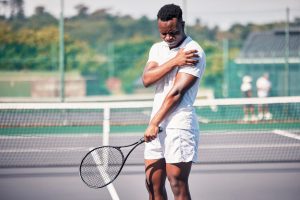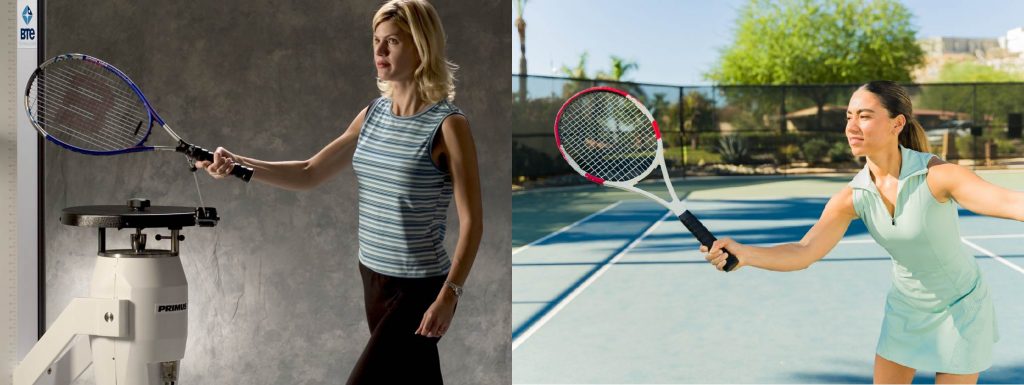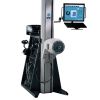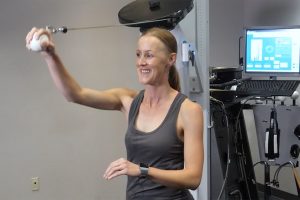
Functional Rehabilitation of Tennis Injuries: Swing, Deceleration, Lateral Movement
Treatment GuidelinesFrom sprinting to deceleration to the different swings and grips, tennis involves high coordination and force production from several parts of the body. Learn how to isolate each movement pattern to help your athletes get back on the court, stronger.
Functional rehabilitation of tennis injuries requires a creative treatment plan. From sprinting to deceleration to the different swings and grips, tennis involves high coordination and force production from several parts of the body. In physical therapy and return-to-sports testing, replicating those movements in the clinic is key. Simulated activities help train the body gradually, build confidence, and improve movement patterns.
In this article, I’ll break down some of the key movement patterns involved with tennis, review common tennis injuries, and discuss how the PrimusRS’ tennis attachments and exercises can be a handy tool for Physical Therapists working with tennis athletes.
Why Tennis Injuries Are so Common
Racket sports have exploded in popularity in recent years. In large part, this is thanks to pickleball, which has become the preferred pastime for seniors, youth, and many others. While all racket sports pose the risk for injury, tennis players are particularly injury-prone due to the unique demands of the sport.
As many can attest, functional rehabilitation of tennis injuries can challenge both the Physical Therapist and the patient. Returning to play after a tennis injury can take a long time, and time off is the last thing a tennis player wants.
For this reason, the newest technology of the PrimusRS can help the rehab professional identify aberrant movement patterns, address painful conditions, and promptly lead patients back toward a long, healthy career on the tennis court. Keep reading for a breakdown of the key principles of functional rehabilitation for tennis injuries.
Tennis Movement Patterns
When working with any athlete, it is always a good idea to start by deeply analyzing their task/sport/work demands. Tennis involves three predominant motions/movement patterns:
- Swing
- Acceleration and deceleration
- Lateral movement
Let’s explore each of these tennis movements and how you can break them down in your functional rehabilitation practice.
The Tennis Swing
Whether you’re talking about the serve, forehand, backhand, or the smash, swinging a tennis racket requires total body coordination and power. Important motions involved in swinging the racket are wrist pronation/supination, shoulder motion in all planes, and trunk rotation, just to name a few.
Timing all of these body movements can be a challenge for tennis players, especially following an injury. Therefore, it’s important to take it slow and be as detailed as possible when rehabbing these patients.
Acceleration and Deceleration in Tennis
Even at the amateur level, tennis players must accelerate and sprint across the court many times throughout a match. Sprinting is an extremely complex movement pattern, which necessitates its own in-depth article to do it justice. However, suffice it to say that sprinting requires significant hip, knee, ankle, and trunk motion, coordination, and power.
Tennis also requires players to quickly stop their momentum in order to set themselves for a swing. Deceleration is equally as important, if not more important than acceleration. To decelerate, the tennis player needs to perform rapid eccentric contractions, putting significant strain through their whole body. Tennis injuries frequently occur during deceleration.
Lateral Movement in Tennis
Tennis players may not need to sprint for every ball, but they will need to move laterally to get to shots that are just within reach. This often requires hip abduction/adduction, reaching, and coordinated movement from many different parts of the upper and lower body.
Functional Rehab for Common Tennis Injuries
As you might imagine, ankle sprains are the most common tennis injury. The constant sharp direction changes require serious ankle mobility and strength.1
After ankle sprains, we frequently see tennis players experiencing low back pain, due to the frequent reaching and rotation. Less frequently, we see shoulder, wrist, and, of course, elbow injuries (such as the eponymous tennis elbow).
While an injury can happen for any number of reasons, it’s important to isolate the various demands of a tennis match during your physical therapy sessions.
Breaking down the components of your patient’s swing and movement can help them regain confidence and correct any aberrant patterns they have developed, which may or may not have led to the injury in the first place.
Functional Rehab for Tennis: Backhand Stroke
In the very acute phase of physical therapy for tennis players, they may not be performing many functional movements. However, it is imperative that athletes practice functional exercises geared toward return to play as soon as possible.
Tennis-specific movements, when incorporated as part of a functional rehab program, can help patients get excited about getting back on the court. Additionally, functional exercises also prepare them for the specific demands of tennis.
The backhand is one of the most technical and difficult strokes for tennis players to master. Further, this is the motion that may most directly contribute to some common tennis injuries, such as lateral epicondylitis.2
Tennis Backhand Basics
The backhand in tennis, like all of the strokes, consists of setting the feet and transferring momentum through the trunk into the upper extremity and into the racket.
However, many people find it difficult to generate enough power with their backhand, due to the inherent awkwardness of having to essentially swing from their nondominant side. As a result, many injuries can result from players sacrificing form in an attempt to swing harder with their backhand.
You should ensure that your patient’s plan of care breaks down each individual portion of the tennis swing, building the player back from the ground up. Using the PrimusRS, the patient can work on many individual parts of the backhand swing, such as gripping properly, supinating/pronating the wrist, and moving laterally before and after hitting the ball.
Simulating Tennis Motions with PrimusRS
Tennis injuries all require specific and individualized treatment plans. For instance, tendinopathy often necessitates the use of eccentric strengthening exercises, especially during the early phase of rehab.
Emphasizing the eccentric phase of a tennis backhand with correct positioning and handgrip is difficult to achieve in the clinic. This is where the PrimusRS comes into play. By making use of the CPM function and the racket handle attachment, Physical Therapists can help patients recover quickly and safely.
Let’s take a look at a few tennis-specific exercises using the PrimusRS.

Functional Exercise for Tennis Injuries: Tennis Racket Gripping
Every single tennis stroke must begin with a proper grip. Gripping on the PrimusRS can be performed isotonically and in various positions to simulate every type of stroke. The specialized tennis racket handle helps your athletes practice in the clinic exactly how they perform on the court.
Functional Exercise for Tennis Injuries: Pronation and Supination
Excessive pronation or supination during a tennis swing can significantly increase the risk of injury. For this reason, controlled wrist motion can help the injured tennis player address any faults in their form before getting back to their sport. PrimusRS’ pronation and supination attachment can help you both evaluate and treat this area.
Functional Exercise for Tennis Injuries: Lateral Slides
As was mentioned earlier, lateral movement is a key part of tennis and an important consideration for the backhand swing specifically. Before they can even set up for their backhand, tennis players have to get into position, and this often requires quick lateral motion.
By attaching straps from the waist to the PrimusRS weighted cable system, the patient can work against resistance as they perform lateral slides. This extra resistance activates muscles used during lateral motion and can help patients perform this movement more effectively.
Functional Exercise for Tennis Injuries: Backhand
Lastly, you can simulate the backhand swing using the PrimusRS tennis attachment. Providing resistance during both the concentric and eccentric phases of the stroke helps from early rehab to return to sport.
Functional Rehabilitation Treatment Template for Tennis Injuries
Want to test and train your physical therapy clients with more tennis-specific movements? We created a treatment template that details functional rehabilitation for tennis injuries with PrimusRS. Click below to download the treatment template.
Conclusion
Tennis is a demanding sport that puts participants at significant risk for injury. However, even the casual tennis player would never be dissuaded from pursuing the sport they love, no matter how great the risk. Physical therapists can help tennis players recover from injury, prevent tennis injuries, and improve their athletic performance. Functional rehab for tennis players should include a breakdown of the key movement patterns, strengthening each part in isolation, and simulated tennis movements for return to sport.
By breaking down the important movement components and using the PrimusRS tennis simulation technology, clinicians can help their physical therapy clients improve form, decrease injury risk, and get back on the court with renewed confidence after an injury.
Bennett Richardson, PT, DPT, CSCS is a Physical Therapist and writer. He is the owner of Richardson PT LLC, a mobile, cash-based physical therapy service out of Pittsburgh, PA. Ben is passionate about many health-related topics including weight loss and athletic performance. To get in touch with Ben, visit www.richardsonpt.com





